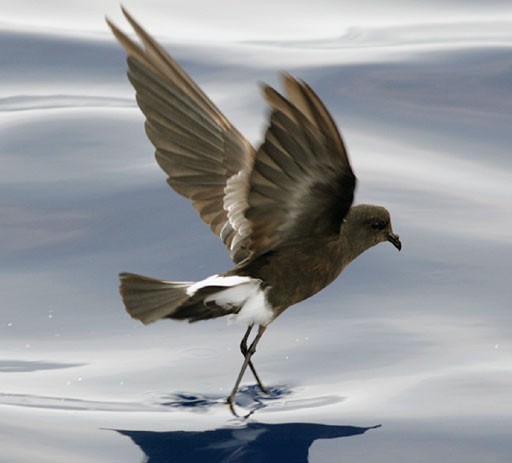Wilson's Storm-petrel
A species of Wilson'S Storm-petrels Scientific name : Oceanites oceanicus Genus : Wilson'S Storm-petrels
Wilson's Storm-petrel, A species of Wilson'S Storm-petrels
Botanical name: Oceanites oceanicus
Genus: Wilson'S Storm-petrels
Content
Description People often ask General Info
 Photo By Patrick Coin , used under CC-BY-SA-2.5 /Cropped and compressed from original
Photo By Patrick Coin , used under CC-BY-SA-2.5 /Cropped and compressed from original Description
Wilson's storm petrel is a small bird, 16–18.5 cm (6.3–7.3 in) in length with a 38–42 cm (15–16.5 in) wingspan. It is slightly larger than the European storm petrel and is essentially dark brown in all plumages, except for the white rump and flanks. The feet jut beyond the square ended tail in flight. The European storm petrel has a very distinct whitish lining to the underwing and a nearly all dark upperwing. Wilson's storm petrel has a diffuse pale band along the upper wing coverts and lacks the distinctive white underwing lining. The webbing between the toes is yellow with black spots in pre-breeding age individuals. 
Size
17-18 cm (6.5-7 in)
Life Expectancy
15 years
Nest Placement
Burrow
Clutch Size
1 egg
Incubation Period
1 brood
Number of Broods
41 - 49 days
Nestling Period
48 - 78 days
Feeding Habits
Wilson's Storm-petrel primarily feeds on small crustaceans, small fish, squid, marine worms, and snails, identified by flight hunting and sometimes shallow diving. Flocks forage opportunistically behind whales and ships, consuming surfaced prey, fish scraps, and debris. Floating carcasses also provide a food source, eaten while flying.
Habitat
Wilson's Storm-petrel typically inhabits Antarctic coastlines and adjacent islands like the South Shetland Islands, favoring rocky shorelines for breeding. Preferring cold, nutrient-rich marine environments, wilson's Storm-petrel thrives in pelagic waters away from land, except during severe storms which may push them closer to headlands. They migrate extensively, reaching northern oceans during the southern winter and favor deeper waters of the continental slope over shallower shelves. Breeding sites are often up to 2,000 feet in elevation and delve 75 miles inland in rocky crevices or holes.
Nest Behavior
Breeding begins with wilson's Storm-petrel digging and lining their nests. Egg-laying patterns are not specified but expectant parents often share incubation duties, alternating between foraging at sea and caring for the egg, until the chick hatches and requires nourishment.
Nest Characteristics
Wilson's Storm-petrel's nests are typically formed in crevices, holes, and burrows within cliffs, rock fields, or scree slopes. These burrows can extend up to 20 inches and may be lined with soft materials like feathers or moss.
Dite type
Aquatic invertebrate eater
People often ask
General Info
Feeding Habits
Bird food type
Behavior
Wilson's Storm-petrel's exhibit a unique blend of social and solitary behaviors, encompassing everything from communal breeding to individual long-distance foraging. They're mostly nocturnal on land, coordinating with cohorts for breeding rituals in the darkest hours, engaging in vocal and flight displays over their colonies. Paired for life, these birds show affection through vocalizations and mutual preening. Remarkably, wilson's Storm-petrel's have adapted to use olfactory cues to navigate and identify partners within their environment. Additionally, during oceanic flights, wilson's Storm-petrel harnesses the wind's power to glide over vast distances. Whether facing stormy gales or calmer breezes, their wing morphology enables them to soar with efficiency and grace. At sea, they embody the spirit of community, often seen congregating in substantial, mixed-species flocks, and performing synchronized roosting activities.
Distribution Area
This species breeds on the Antarctic coastlines and nearby islands such as the South Shetland Islands during the summer of the southern hemisphere. It spends the rest of the year at sea, and moves into the northern oceans in the southern hemisphere's winter. It is much more common in the north Atlantic than the Pacific. Wilson's storm petrel is common off eastern North America in the northern summer and the seasonal abundance of this bird in suitable European waters has been revealed through pelagic boat trips, most notably in the area of the Isles of Scilly and Great Britain. It is strictly pelagic outside the breeding season, and this, together with its remote breeding sites, makes Wilson's petrel a difficult bird to see from land. Only in severe storms might this species be pushed into headlands. 
Species Status
Not globally threatened.
Scientific Classification
Phylum
Chordates Class
Birds Order
Albatrosses and Petrels Family
Hydrobatidae Genus
Wilson'S Storm-petrels Species
Wilson's Storm-petrel